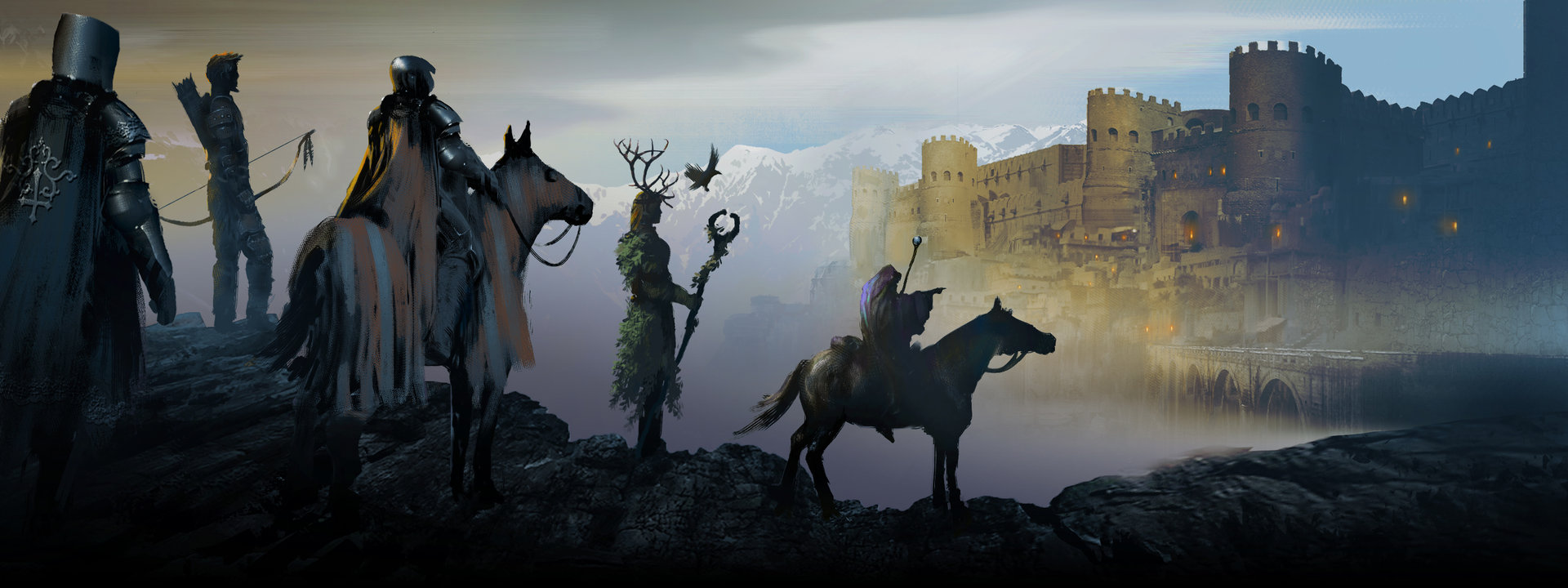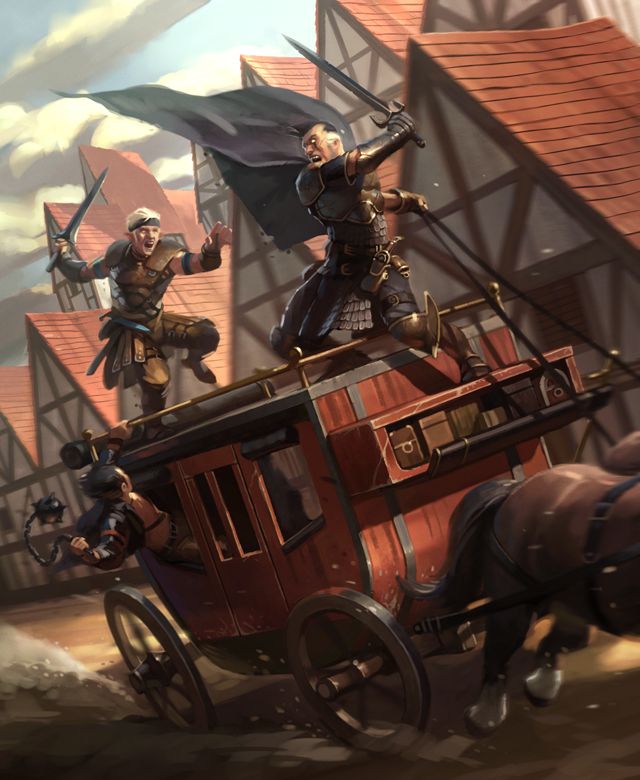Homebrew: Mounted Chase Rules
For use with homemade chase cards (can be made on index cards if normal blanks aren't available). List of cards will be added to this document shortly. To explain how the rules work, I'll use an example from an adventure I recently wrote.
Keep in mind that the base speeds of animals (horses, etc.) from the Monster Manual are being used to determine distances covered per round. Dashing, like normal, doubles the distance.
Here's the example...
A gnomish wagon is being pursued by mounted assassins!
The gnomish theater wagon is pulled by a draft horse with a base speed of 40'. The pursuers are on riding horses each with a base speed of 60'. So if the chase continues without complications (or forced complications) the assassins will eventually catch up with the PC's.
Thankfully, the party has options and improvised weapons at their disposal. There are four barrels, as well as a ton of smaller theatrical props and a tub filled with juggling balls, all in the back of the covered wagon.
We can use modified chase cards to simulate the distance between the pursued and the pursuers, as well as the track itself.
If the party sticks to the road, they'll find fewer obstacles and favorable terrain. The horses can dash for an hour before gaining exhaustion, and likely the chase will not last this long.
The base speed and dash speed of each horse stands as normal as long as they stick to the road.
To avoid having the pursuers catch up to them, the PC's essentially have two options: the passengers can create obstacles or attacks in an attempt to slow or stop the assassins, or they can risk rougher terrain, depending upon their hopefully superior navigational and animal handling skills to out maneuver the enemy.
It may end up being a combination of both as their improvised obstacles are limited, and they likely have some form of disadvantage on attack rolls due to the speed they are traveling.
If at any point a horse is made to leap, it's maximum distance is 1.5x its STR score, unless it is pulling a wagon, in which case the leap distance is simply its STR score.
Further, the wagon (in this example) has an AC 15 and 27 (5d10)HP, and there's a chance it will take damage on a leap (roll an attack with no modifiers to determine if wagon takes 1d6 damage).
The terrain the chase participants choose determines the percentage chance of an obstacle. Lay out an obstacle card, face down (obstacle side) for every 20' of movement (round down but keep tally of extra distance). Consult the following chart and flip a card if the roll falls (only time you flip) within the percentage chance of an obstacle occurring.
Chance of Obstacle Occurring
Percent Chance Terrain Type
25% Road (dirt or paved), new bridge
50% Off-road (grass, dirt, etc), old bridge
75% Rocky or blasted earth, damaged bridge
100% Woods, River Crossing*
*auto draw stream/river fording card
The chase will continue until one group is either hobbled, destroyed, exhausted, or the quarry is caught.
It should be noted that the cards are all uniform on one side (the "safe" side) and have skill challenges printed on the other. Typically there will be two options for which skill challenge the PC wishes to take. Normally, the "driver" is the one to perform these skill checks, especially as "animal handling" is often employed.
List of Cards coming soon!
12/3/18 UPDATED WITH CARD CONTENTS --see below--
VEHICULAR/HORSE CHASE RULES:
Let’s do the wagon or cart first. How is a wagon different than a horse?
More weight
More passengers (who can do other things during the chase)
Lead vehicle can create obstacles by jettisoning items
Normal ranged attacks
Horses are naturally faster without carts so in order to not have them take the lead, something must be done by a passenger.
Add to this road/ground complications for all parties.
Draft Horse 40’/turn
Riding Horse 60’/turn
Gallop = 2x base speed for 1 hour, so 80’ vs 120’
If we want to use cards, we should make the intervals 20’ rather than 10’.
Or we can do a combination of chart and cards. Roll every 40’ to see if there’s a complication, and if so, draw from the pile and place on the course.
If the road or path is wide enough, the follow vehicle can attempt a different path. Though non-roads may be considered difficult terrain, thus slowing it down.
Rough Model for Terrain:
1. Road, no modifier
2. Grass, mild terrain 1.5x cost
3. Mud or rocky, rough terrain 2x cost
4. woods, automatically run tests and cost = 1.5 movement
5. Uphill, 2x cost
6. Downhill, gain +10 movement
If within 10’, can attempt to jump from horse to wagon or vice versa.
Caltrops, barrels, rocks and the like, can be dodged with animal handling check, or if dropped ahead of follow vehicle has potential to increase terrain difficulty.
Those inside carriage or wagon may have full or partial cover.
Stick to the road to avoid complication checks (maybe reduce number of complication checks to 1 every 2 cards instead of every card).
So, how would we construct a path? Mark it out with cards, and whenever a roll forces a card to flip, you have the other side with a complication.
List of complications (card contents):
1. Hole/Crack in earth (leap over Horse DEX score + animal handling prof bonus, success gain +10’, fail = DC10 DEX save or fall off horse /go around animal handling, fail = lose 10’)
2. Small Stream crossing (power through [lose 10’] or leap high DC, failed leap save to not fall prone, success = lose 20’)
3. Brambles or other small obstacles (either navigate around it or make Dex Save to power through)
4. Narrow path, slow to avoid branches (no roll, lose 10’), or power through at have attack roll against you made for damage
5. Wide Mud reduce speed 1/3
6. Narrow Mud reduce speed 1/3 or attempt navigate
7. wide rocky ground reduce speed 1/2
8. rocks (pile) in road: reduce speed 1/2 or attempt to go around
9. rotten bridge reduce speed 1/2 or roll dex save or fall prone
10. Incline steep 1/2 speed, or power through and make con save for exhaustion
11. Decline steep stay same or animal handling to gain 10’, fail by more than 5 fall off horse
12. slippery ground (animal handling or slow)
13. overhanging, tangled woods (navigate or slow)
14. Low blockage, leap, go around or slow
2x13=26 all cards except 9
1 extra for, incline, decline, rocks in road, mud strip
So, lets map this out. If average mounted speeds range between 40-60/80-120, then the smallest increment can be 40, but there are too few cards. If roads mean you can skip a card, you need at least two cards per section. If off road means every card is checked, this still works.
Or every card could be a potential flip but the percentage chance changes based upon terrain.
25% on road
50% off road
75% on rocky terrain
100% forest
Horse long jump is 1.5x its STR
Long jump w/carriage 1x STR
Remove these ads. Join the Worldbuilders Guild




Comments